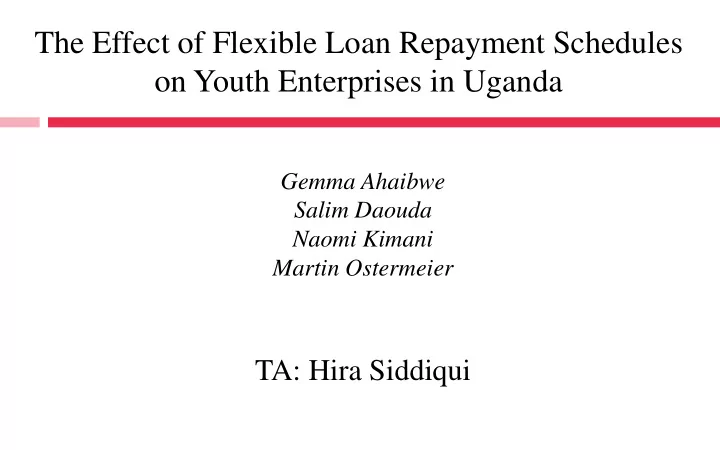

The Effect of Flexible Loan Repayment Schedules on Youth Enterprises in Uganda Gemma Ahaibwe Salim Daouda Naomi Kimani Martin Ostermeier TA: Hira Siddiqui
Background National Youth Unemployment rates (%) High youth unemployment and underemployment rates 19.3 17.4 13.3% unemployed (relaxed definition) 13.3 11.4 63.2 percent 8.7 underemployed/underutiliz ed Wage employment in public and private sectors accounts for only 24.6% of employed youth, Male Female Urban Rural Uganda Source: SWTS (UBoS, ILO, 2013)
Background As a result of youth unemployment, and narrow wage sector, youth are more likely to be in self employment (micro enterprises), (74.8%) However, there is low investment and enterprise growth among youth business startups, and high business failure (for every business started nearly another closes down (GEM, 2004) Literature shows that access to micro-credit has improved however their repayment inflexibility may not provide the necessary time for investments to show a yield. Hence the need for our intervention (flexible loan grace period and its effect on business investment and performance
Theory of change Need Low investment and survival rates Assessment for youth start ups Provide flexible loan Intervention repayment/grace period schedules Take up of flexible loans by Outputs youth enterprises Increased access to Intermediary flexible loans outcomes Increased business investment and performance (e.g. profits, number of employees, investments, business survival) Outcomes 4
Assumptions and Indicators TOC Low investment and Assumptions Indicators survival rates for youth start ups Intervention / Provide flexible loan Short/No grace -Intervention (1 or 0 Inputs repayment/grace period period barrier to assignment to control schedules investment and treatment) Outputs Take up of flexible loans by Applicants take up - Number of loans youth enterprises the loans disbursed by grace period and applicant Intermediary Increased access to flexible - Take up rate outcomes loans - Assets purchased Outcomes Increased business Loans are invested in -Return on investment and performance businesses Investment/value of (e.g. profits, sales, number of Conducive business assets employees, investments, environment -Number of business survival) employees
Evaluation Questions and Outcomes Does increased loan grace period correlate with increase in business investment and performance Outcomes Investments, profits, number of employees, business survival
Evaluation Design TREATMENT 1 (6 month) n 1 =8,100 Population of Uganda Youth population in Youth population in (n=6,764,197) (n=37,578,876) (18-30 years) (n=250,275) Uganda Kampala TREATMENT 2 (9 month) n 2 =1,825 CONTROL (1 month) n 1 =8,100 Randomisation: Individual level n 2 =1,825
Data Sources 1) Largely based on survey data Assignment End line Evaluation Baseline Measure (Control and survey (one sample survey Impact Treatment) year) 2) To a small extent administrative data
Sample Size Pre-test Control Treatment 1 Treatment 2 (1 month) (+ 6 month) (+ 9 month) Mean US$ 297 US$ 302.94 US$ 315.06 US$ 333.23 (monthly net profit) SD = US$ 469 Expected change . + 2% + 6% + 12% R 2 . . 0.5 0.5 α . . 0.05 0.05 δ . . 0.02193 0.0549 n . . 24,299 5,475
Power Calculation
Potential Challenges Take up rate: 85% target Compliance: high, maybe on supply side Attrition: 5% no systematic Spillovers: not much to worry about How to manage the challenges Adjust sample size to take care of these challenges Good monitoring checks
Results Target audience Governments and policy makers, NGOs with credit components, Micro finance institutions Research community Dissemination channels Workshops Policy briefs, research paper Targeted meetings
Recommend
More recommend